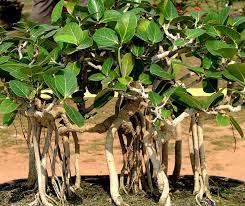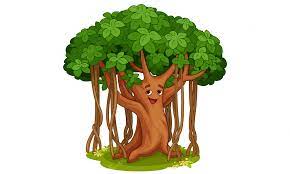Banyan tree
Today we are going to learn about this tree. Banyan (Marathi name: Vada ; Classical name: Ficus benghalensis, Ficus bengalensis; English: banyan tree) is a large tree native to the Indian subcontinent. Vada is a species of Ficus bengalensis belonging to the genus Ficus. This huge, sprawling tree generally grows 15 to 20 meters tall. The roots of its branches reach the ground. They are called Parambya. After reaching the ground, these branches start to take the shape of trunks and from it the other trunks formed around the main trunk of the tree expand. This tree is also called ‘Nyagrodha’ as it comes down from above. This tree is first seen in West Bengal so it is called bengalensis, while in Bengali it is called Baniya, so it is called banyan tree in English.

Ancient and sprawling banyan trees are found in some cities of India. A banyan tree is spread over two and a half acres of land at Vadchincholi in Chhindwara district of Madhya Pradesh. The tree in the village of Komitit in Bihar, Kabirwat near the mouth of the Narmada in Gujarat, the sprawling grove in Calcutta’s Shivfoot Botanical Garden is so huge that four to five thousand people can sit under its shade. Banyan tree in Shivfoot Botanical Garden is 350 years old. There are similar ancient wada trees at the Theosophical Society of Adyar in Madras and near the city of Satara. Also, the banyan tree in the village of Ambashi near Patur is spread over an area of about half an acre.
Stem, leaves, flowers, fruits
The stem of vada is strong, smooth and chewy. The leaves are large, broad, rounded, slightly elongated. The stem and tip of the leaf are rounded. These leaves are dark green in color, soft, flaky. But the back is pale. Greenish in color, the flowers and fruits are very small, inconspicuous. Many times they look like fruit. But it is a flower. Its fruits are borne on branches, trunks, between leaf stalks and trunks. At first they are green but tough. Red and soft when ripe. Different birds and monkeys love those fruits. Vada fruits are beautiful. The red, rounded, leaves are in pairs along the stems. The fruit contains small larvae and worms. So people do not usually eat these fruits. Fruiting season is from February to May.

Krishnavat
There is a type of vada called “Krishnavat”. Its leaves are slightly curved and look like a drona. One day when Gopalkrishna went to the forest with the cows, the gopis lovingly went there with butter and started feeding it to him insistently. Then Gopala fed that butter to all his relatives and awakened the sense of harmony in his mind. Gopi, Savangadi and Srigopal became one. To distribute this butter to everyone, they cut the leaves of the vada and crushed it a little and prepared its drona. Since then, the leaves of that banyan tree became like Drona and continued to produce similar leaves. There is a legend that such a banyan tree got its name as ‘Krishnavat’.

usage
Patravali is used for food of wad leaves. Roots, leaves, flowers, leaves and bark are all used as medicine. Chik is used to heal wounds, stop toothache. Hair oil is prepared by adding vada seeds. If you add vada parmiya to shikekai, boil it and wash your hair with that water, hair grows.
National importance
Vad is the national tree of India.
Cultural/religious significance
Banyan tree is a part of Indian culture. The festival of Vatpurnima is associated with this tree. Savitri brought the life of her husband Satyavan. Satyavana was brought alive under this tree by worshiping Yama, so Suvasini women worship this tree on Vatpurnima to wish their husbands a long life.
Among the four Vedas, Vada is mentioned in Rig Veda and Atharva Veda. When the Kurukshetri gods performed the great sacrifice, they placed Somachamsa’s face downwards. The Shatapatha Brahmana has the story of its origin that Somchamsa became a banyan tree. Vad is a sacrificial tree and sacrificial vessels are made from the wood of this tree. There is a legend that before the creation of creation, Lord Vishnu used to sleep as a child on a reed in the water during the flood. Hindus believe that ‘Vad’ is the abode of Lord Brahma. Lord Shiva is also believed to reside on this tree.
Sourse : Wikipidiya in Marathi
https://mr.wikipedia.org/wiki/%E0%A4%B5%E0%A4%A1
Read More
Faq
1 What is the scientific name of Banyan tree ?
2 Banyan tree is mentioned in which Veda ?
3 What are the uses of Banyan tree ?